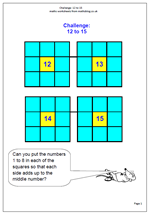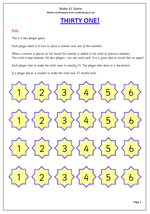 I have not put up many challenges and investigations recently so I thought I would redress this over the coming weeks with some fun and challenging tasks. Using and Applying Maths has been a cornerstone of the Primary Framework for Mathematics and these kinds of activities are important in making children think through a problem and work in a logical, well organised way.
I have not put up many challenges and investigations recently so I thought I would redress this over the coming weeks with some fun and challenging tasks. Using and Applying Maths has been a cornerstone of the Primary Framework for Mathematics and these kinds of activities are important in making children think through a problem and work in a logical, well organised way.
This challenge is actually in four parts, but one the first has been cracked the same method can be applied to the others. A 3 by 3 square grid has the number 12 in the middle. The challenge is to place each of the digits from 1 to 8 around the grid so that each side across and down adds up to the middle number (12).
A really good way to approach this task is to cut out the numbers from 1 to 8 so that they can easily be moved around the grid. There are several different solutions to the task, but they all have a similar pattern.








